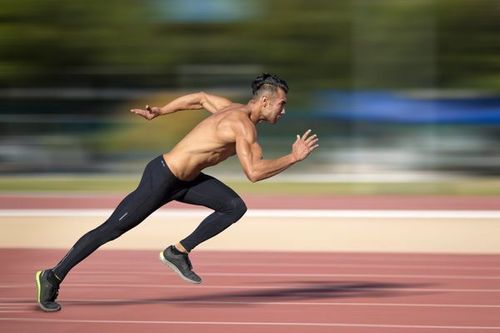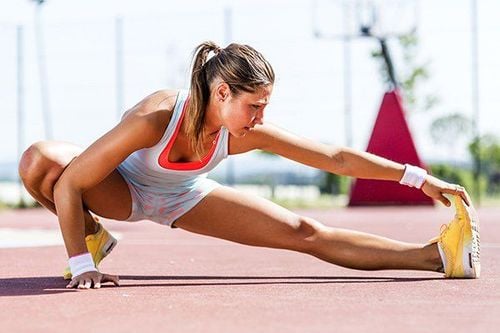This is an automatically translated article.
100m short distance running, also known as fast running, is a popular subject in sports competitions, including student competitions. However, not everyone clearly understands the technique of running 100m fast to achieve the best goal as well as avoid unwanted injuries. Here is the correct technique for running a short distance of 100m.1. Warm up before running short distances
The purpose of the warm-up process is to help the muscles contract faster, preparing for the training process. Warm up so that the muscles get used to strong activities, avoiding injury in the 100m running technique. Specifically:
5 minutes of cardio for athletes to warm up before training by running around the track. Practice stretching and movement: Dynamic movements and active stretching need to be emphasized. These stretches and workouts will help you hit your warm-up goal before hitting the 100m sprint. Focus on technical exercises: Technical exercises must be performed correctly. If you can do this, it will help train your acceleration and sprinting abilities well. Acceleration: While practicing the technique of running 100m fast, attention should be paid to training the ability to accelerate. This is essential in races. Do the acceleration 3-4 times. The following workouts must do more acceleration times than the previous one

Khả năng tăng tốc là một kỹ thuật rất cần trong chạy cự ly ngắn
2. Prepare for the 100m . sprint
Preparation is an extremely important part, a good start, then the next steps can be done well. The preparation step has a great influence on the technique of the 100m run and the success of the run.
Step 1: Put your hands on the ground, in front of the starting line. Hands shoulder width apart. Extend your hand so that your fingers are apart and form an arch or bridge. This movement makes the body more stable and easy to bounce when starting. Step 2: Place your dominant foot in front of you at the level of your hand. The non-dominant foot (the other foot) is placed at the back. One point to note is that both toes need to touch the running track. Otherwise, it will be considered illegal. Step 3: Lower the back knee to the road so that the thigh of the hind foot is perpendicular to the road. Note that the head and back are straight naturally, not stooped, not bowed. Eyes look forward about 40-50cm from the starting line. Focus your body weight on your hands, front feet, and back knees.
3. Starting the right way
After completing the preparatory movements, the next step in the 100m sprint technique is the start.
On the yellow ready signal, shift your body weight forward, raising your butt to or above your shoulders. Stretch your shoulders in front of the starting line by 5 - 10 cm. Attention, stay in this position until the next command of the referee.
After hearing the command to run, you kick hard with both legs, and at the same time push your hands out of the running track. Swing your arms to the side with your legs. This movement is very important, both helping the runner maintain balance and supporting the back pedal force of the two legs.
Note, quickly bring the back foot forward to complete the first run. Don't push the back foot all the way. As for the front foot, pedal to straighten all the joints and then leave the pedal. Quickly bring the front foot forward to perform and complete the second run. Then continue with the next steps.
4. Run
You will enter the dash after your hands leave the road. The running speed at this time will gradually increase, the leaning of the upper body forward will decrease. Along with that, the hand hitting power also decreases. When taking the first steps, it is advisable to let the legs placed on the track spread slightly apart and then gradually decrease.
Rushing speed depends on stride length. It is recommended to run with the back steps 1⁄2 feet longer than the front step and after 9-11 steps, keep at a stable level.
Must practice regularly and with correct technique to achieve high efficiency.

Hãy luyện tập thường xuyên và đúng kỹ thuật để đạt hiệu quả cao trong chạy cự ly ngắn
5. Mid-distance running
After performing a javelin run, it is a mid-range run. The primary task of this step is to maintain the high speed achieved in the dash. When running in the middle of the interval, pay attention to the following points:
The front foot changes from the upright state to the rear pedal. At the same time, bring the foot forward. Raise your lower leg to almost parallel to the ground. The back pedal movement greatly affects the mid-range running speed. Therefore, this movement needs to be done quickly, forcefully and in the right direction. The foot pedal must be brought quickly and in the right direction to be able to support the rear pedal movement. Shoulders and hips should shift forward as soon as the front foot touches the ground. This movement helps the body to quickly switch from front to back pedal. Hit staggered hands and match the rhythm of the legs. Both hands are half-closed or fingers can be extended. When running, both hands are bent at the elbows.
6. Reach the finish line
When athletes are only 15-20 meters from the finish line, it is necessary to focus on maintaining speed. Lean forward to increase the efficiency of the rear pedal. Increase speed at this distance to quickly reach the finish line. A runner is deemed to have finished when any part of the upper body (except head and arms) touches the vertical plane containing the finish line. Therefore, in this race, you need to bend your upper body forward or rotate your body so that your shoulders reach the finish line.
In the 100m running technique, do not jump to the finish line when not far from the finish line because it will be slower. Continue running for a few more steps after you reach the finish line and keep your balance to avoid falling. Never stop suddenly after reaching the finish line.
For people with health problems, such as cardiovascular disease, diabetes or a history of injury... need to consult a doctor and specialist before running.
Please dial HOTLINE for more information or register for an appointment HERE. Download MyVinmec app to make appointments faster and to manage your bookings easily.
Reference source: thespeedproject.com












